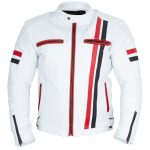Dia de los muertos dress up, also known as the Day of the Dead, is a vibrant and meaningful celebration in Mexican culture. During this holiday, people honor their deceased loved ones through joyful festivities. Dressing up for Dia de los Muertos allows individuals to pay homage to this tradition while expressing their creativity and personal style. In this article, we will provide you with tips and ideas on how to create authentic and stylish outfits for Dia de los Muertos celebrations.
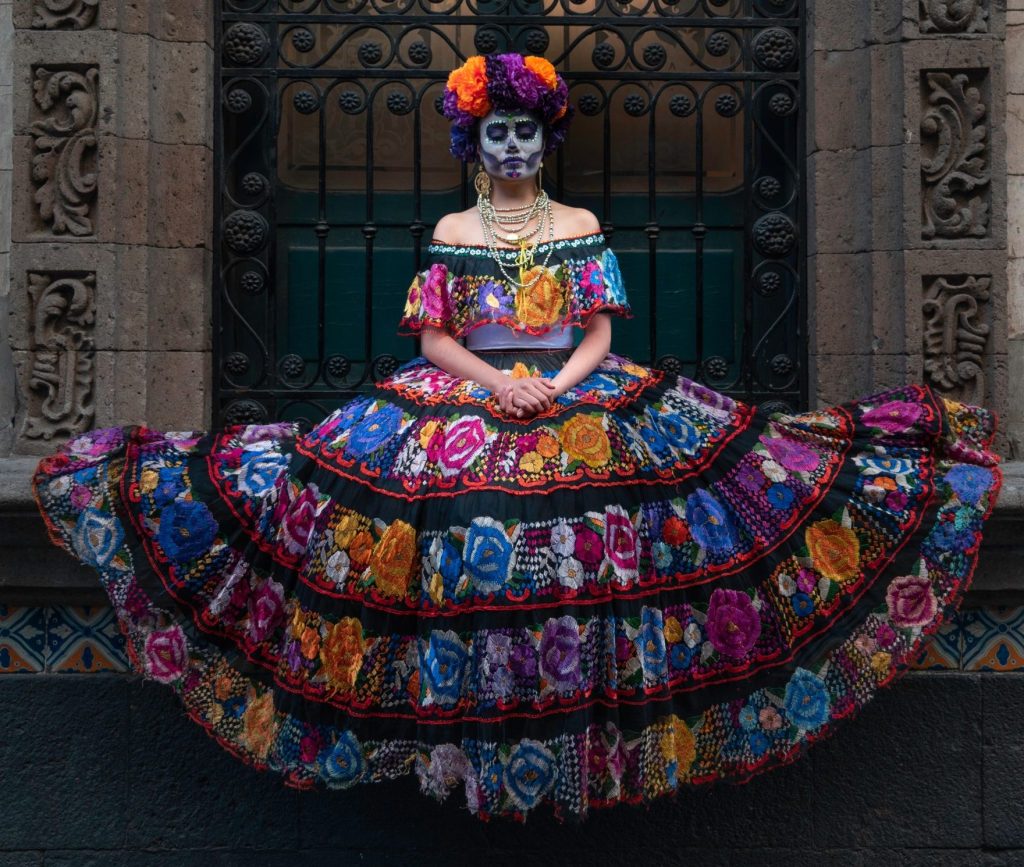
Traditional Elements:
- Calavera (Skull) Makeup: Dia de los Muertos is synonymous with striking calavera makeup, featuring elaborate skeletal designs with colorful accents. To achieve an authentic look, use face paint or makeup in white, black, and vibrant shades such as red, blue, or yellow. Decorate the face with intricate designs like flowers, spiderwebs, or hearts to symbolize life and remembrance.
- Skeleton-inspired attire: Incorporate skeleton motifs into your outfit through printed tops, leggings, or even dresses. Look for clothing options adorned with colorful calacas (skeletons) or traditional sugar skull designs. Pair them with contrasting vibrant colors to create a visually striking ensemble.
Color Palette and Fabrics:
- Vibrant Colors: Embrace the festive spirit of Dia de los Muertos by choosing outfits in bold and lively colors. Incorporate hues such as deep red, bright orange. Vibrant yellow, electric blue, and rich purple. These colors represent the vibrancy of life and celebrate the notion of joy even in the face of loss.
- Traditional Fabrics: Opt for garments made from traditional Mexican fabrics such as lace, crochet, or embroidered textiles. These fabrics add a touch of cultural authenticity to your ensemble. Look for dresses, blouses, or shawls with intricate embroidery or lacework.
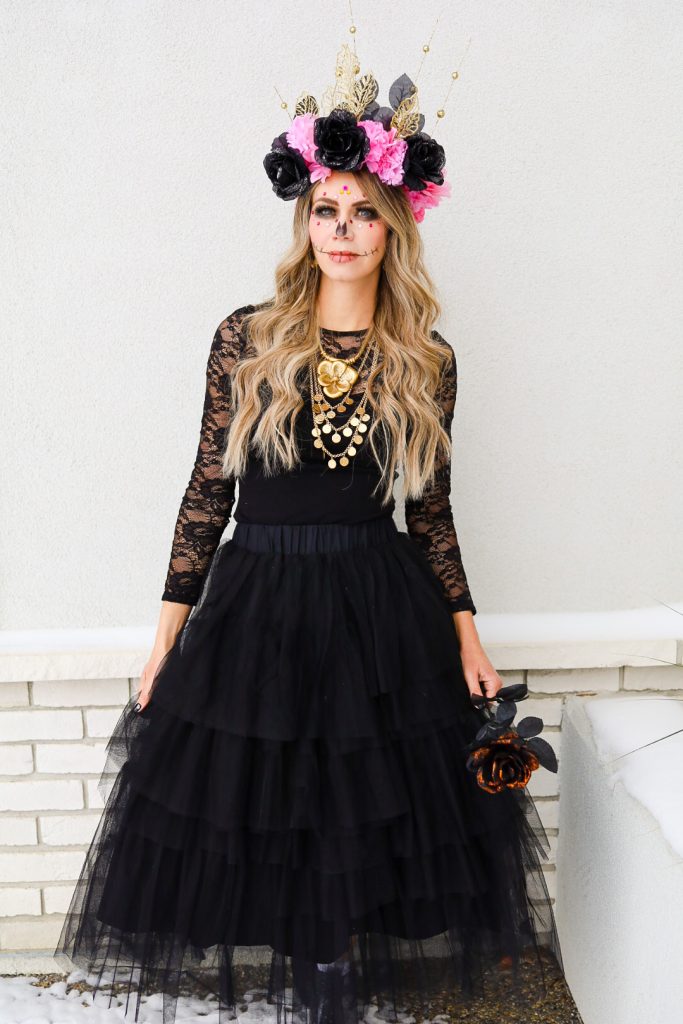
Traditional Clothing and Accessories:
- La Catrina Inspired Dress: La Catrina is an iconic figure associated with Dia de los Muertos. Her elegant and ornate attire includes a long, flowing dress. Look for dresses in black, vibrant red, or white, adorned with lace, embroidery. Or lace appliques. Pair it with a colorful shawl or veil for a dramatic effect.
- Traditional Embroidered Blouse: A traditional blouse featuring intricate embroidery, such as the Oaxacan or Puebla style, can be paired with a colorful skirt or pants. Complete the look with accessories like a wide-brimmed hat and a statement necklace.
Accessories and Details:
Floral Accents:
Flowers play a significant role in Dia de los Muertos as symbols of life and remembrance. Incorporate floral accents into your outfit by wearing flower crowns, hair clips, or intricate floral prints.
Flower Crowns:
- Marigold Crowns: Marigolds (cempasúchil) are the quintessential flower of Día de los Muertos, believed to attract spirits with their vibrant orange hue and strong scent. Wearing a marigold crown instantly ties your look to the holiday’s core symbolism.
- Mixed Flower Arrangements: Combine marigolds with other flowers like roses, dahlias, or lilies to create a more diverse and personalized crown. Each type of flower can represent different emotions or memories associated with loved ones.
- DIY Options: Crafting your own flower crown using fresh or artificial blooms allows you to customize the design and ensure it perfectly complements your outfit.
Headpieces and Assorted Hair Accessories:
Create an eye-catching Dia de los Muertos look by wearing elaborate headpieces adorned with flowers, feathers, lace, or even mini sugar skulls. Consider colorful hair extensions, ribbons, or bows to add an extra festive touch to your hairstyle.
Footwear and Makeup:
- Traditional Mexican Huaraches: Complete your Dia de los Muertos ensemble with traditional Mexican huaraches or embroidered sandals. These handcrafted shoes add an authentic touch to your outfit and ensure comfort during celebrations and parades.
- Eye-catching Nail Art: Extend the Dia de los Muertos theme to your nails by incorporating intricate and vibrant designs. Use bright colors, calavera motifs, flowers, or sugar skull patterns for a festive and coordinated look.
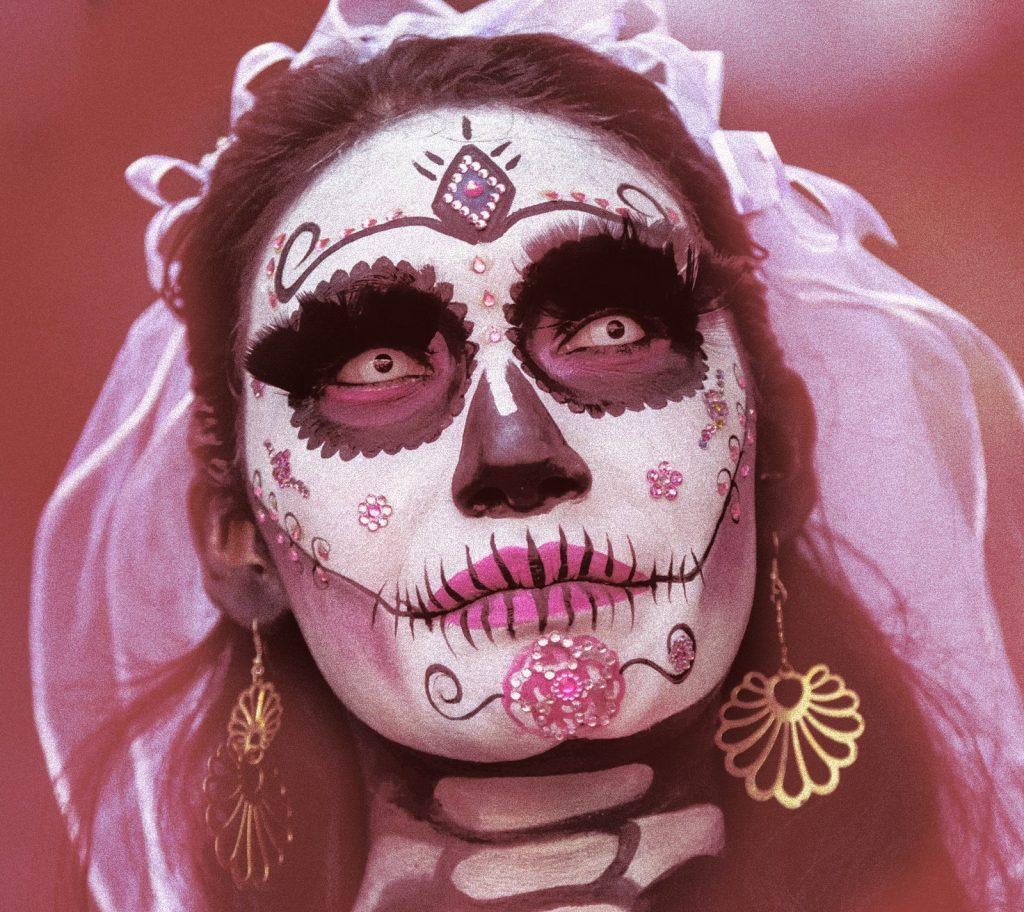
Features of dia de los muertos dress up
Día de los Muertos, or the Day of the Dead, is a vibrant and culturally significant celebration that honors deceased loved ones with joy, reverence, and creativity. The dress-up style associated with this holiday is one of its most iconic and visually striking features. Participants embrace elaborate costumes, makeup, and accessories that reflect the rich symbolism and traditions of the celebration. Below are the key features of Día de los Muertos dress-up:
1. Calavera (Sugar Skull) Makeup
- Symbolism: The calavera, or sugar skull, is one of the most recognizable elements of Día de los Muertos attire. It symbolizes the cycle of life and death and serves as a playful yet respectful nod to mortality.
- Design Elements:
- Bright Colors: Bold hues like red, yellow, blue, green, and purple are used to create intricate patterns on the face.
- Floral Motifs: Flowers, especially marigolds (cempasúchil), are often incorporated into the design to represent the fragility and beauty of life.
- Symmetry: Traditional calavera makeup is symmetrical, with detailed designs mirroring each other on both sides of the face.
- Personalization: While there are common themes, individuals often add unique touches to their makeup, such as glitter, rhinestones, or personalized symbols.
2. Marigolds (Cempasúchil)
- Symbolic Importance: Marigolds are considered the “flower of the dead” and are believed to guide spirits back to the world of the living during Día de los Muertos. They are often incorporated into costumes and accessories.
- Usage in Dress-Up:
- Floral Crowns: Many participants wear crowns or headpieces made of marigolds, which add vibrancy and authenticity to their look.
- Hair Accessories: Marigold flowers may be woven into braids or pinned into hairstyles for a festive touch.
- Decorative Accents: Fake marigolds are sometimes attached to clothing, hats, or props to enhance the overall aesthetic.
3. Traditional Mexican Clothing
- Women’s Attire:
- Embroidered Dresses: Women often wear traditional Mexican dresses adorned with colorful embroidery, which reflects regional styles and cultural heritage.
- Rebozos: Shawls or scarves, known as rebozos, are draped over the shoulders or head, adding elegance and tradition to the outfit.
- Men’s Attire:
- Charro Suits: Men may wear charro suits, which consist of tailored jackets, fitted pants, and wide-brimmed sombreros. These outfits are typically decorated with intricate embroidery and metallic embellishments.
- Guayaberas: Lightweight shirts with decorative pleats, called guayaberas, are another popular option for men.
4. Skeleton-Inspired Costumes
- La Catrina Influence: The figure of La Catrina, an elegantly dressed skeleton created by artist José Guadalupe Posada, heavily influences Día de los Muertos dress-up. Participants often emulate her sophisticated yet skeletal appearance.
- Full Skeleton Outfits: Some people wear full-body skeleton costumes or printed leggings and tops that resemble bones.
- Accessories: Skeleton gloves, masks, or even props like fake skulls complement the theme.
5. Vibrant Colors and Patterns
- Color Palette: Bright, bold colors dominate Día de los Muertos dress-up, reflecting the lively and celebratory nature of the holiday. Common colors include:
- Orange: Representing marigolds and the sun.
- Purple: Symbolizing mourning and remembrance.
- Pink: Reflecting joy and celebration.
- White: Signifying purity and hope.
- Patterns: Traditional textiles like embroidered florals, geometric designs, and papel picado-inspired motifs are frequently incorporated into clothing and accessories.
6. Incorporation of Papel Picado
- Papel Picado Details: This traditional Mexican craft involves cutting intricate designs into tissue paper and hanging it as decoration. For dress-up, papel picado patterns are sometimes replicated in fabric or added as accents to skirts, shawls, or hats.
- DIY Elements: Some participants create their own papel picado-inspired accessories, such as belts, sashes, or hairpieces, to personalize their outfits.
7. Accessories and Embellishments
- Jewelry: Traditional jewelry, such as beaded necklaces, earrings, and bracelets, adds flair to the ensemble. Silver and turquoise pieces are particularly popular due to their connection to indigenous Mexican cultures.
- Hats and Headpieces: Wide-brimmed sombreros, floral crowns, or veils are commonly worn to complete the look.
- Props: Participants often carry items like candles, small altars, or offerings (ofrendas) as part of their costume to honor their ancestors.
8. Modern Interpretations
- Fusion Styles: In contemporary celebrations, people blend traditional elements with modern fashion trends. For example, someone might pair a calavera makeup look with casual streetwear or incorporate neon colors into their outfit.
- Cultural Exchange: As Día de los Muertos gains global popularity, non-Mexican participants adapt the dress-up style to suit their own cultural contexts while still respecting its origins.
9. Family-Friendly Adaptations
- Children’s Costumes: Families often involve children in the festivities by dressing them in miniature versions of traditional outfits or simpler skeleton-themed costumes.
- Matching Looks: Coordinating family costumes—such as everyone wearing similar color schemes or matching floral crowns—creates a sense of unity and shared purpose.
10. Spiritual and Emotional Expression
- Honoring Loved Ones: Many participants incorporate personal touches into their dress-up to pay tribute to specific ancestors. This might include wearing a relative’s favorite color, flower, or piece of jewelry.
- Emotional Connection: The act of dressing up becomes a form of storytelling, allowing individuals to express their feelings about loss, memory, and the continuity of life.
The dress-up style of Día de los Muertos is a beautiful fusion of art, culture, and spirituality. Each element—from calavera makeup and marigold accents to traditional clothing and symbolic accessories—carries deep meaning and contributes to the overall vibrancy of the celebration. By embracing these features, participants not only honor their ancestors but also celebrate the richness of life itself. Whether adhering to time-honored traditions or incorporating modern twists, Día de los Muertos dress-up remains a powerful way to connect with heritage, community, and the universal human experience of remembering those who have passed.
Vibrant and Symbolic Colors:
Vibrant hues:
Dia de los Muertos dress up is characterized by an explosion of vibrant colors that represent the celebration of life. Bright and rich shades of red, orange, yellow, purple, and green are commonly used. These vibrant colors symbolize joy, vitality, and the vibrancy of life itself.
White and black:
While bold colors dominate dia de los muertos dress up, white and black are also significant. White represents purity and is associated with angels and the afterlife, while black symbolizes the pre-Hispanic origins of the holiday and the Mexican clothing traditions.
Traditional and Symbolic Attire:
La Catrina:
La Catrina, the elegant and skeletal figure, is an iconic symbol of Dia de los Muertos. Her attire often includes a wide-brimmed hat, veiled hat, and ornate jewelry, and an elaborate dress or gown. This attire embodies elegance, grace, and the theatricality of the holiday.
Traditional Mexican attire:
Many individuals embrace traditional Mexican garments during Dia de los Muertos celebrations. Traditional attire, such as embroidered blouses, colorful skirts or dresses, and rebozos (shawls), pay homage to the rich heritage and cultural diversity of Mexico.
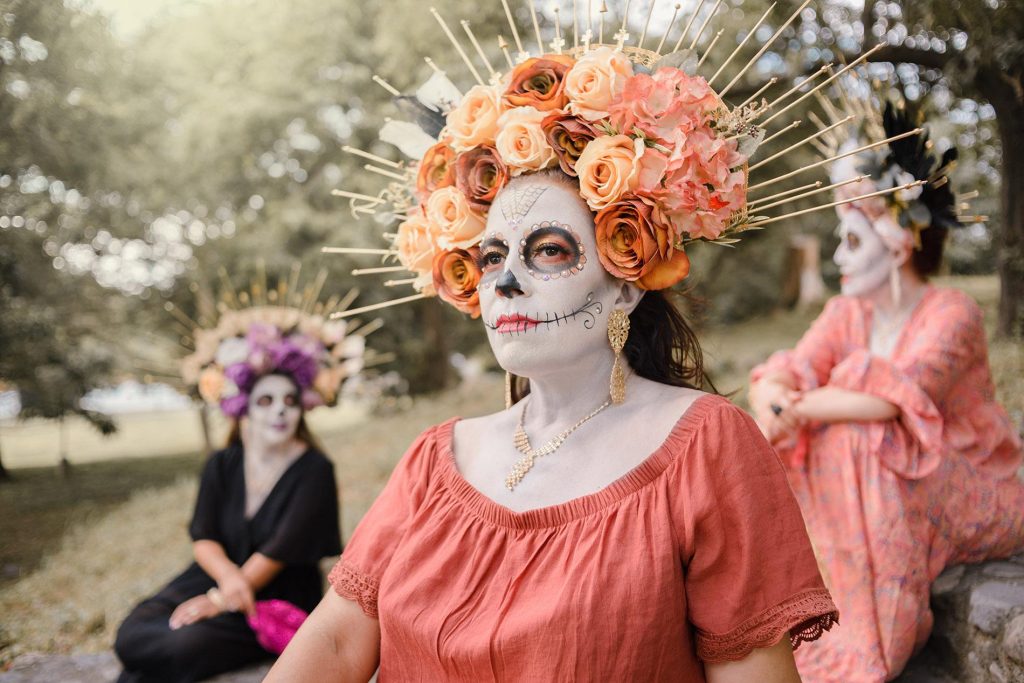
Symbolic Elements and Embellishments:
Calaveras (Skulls) and Sugar Skulls:
Dia de los Muertos is synonymous with striking calaveras makeup and sugar skulls. These elements are incorporated into dress up through various means, including face painting, masks, jewelry, and clothing adorned with calavera or sugar skull designs. Calaveras represent the playful and festive approach to death during the holiday.
Marigolds (Cempasúchil):
Marigolds are an integral part of Dia de los Muertos as they are believed to guide the souls of the deceased back to their loved ones. These bright orange flowers are often worn as accessories, incorporated into headpieces, or used for decorative purposes during celebrations.
Cultural Artistry and Handicrafts:
Embroidery:
Embroidery is a traditional Mexican art form, and Dia de los Muertos dress up often includes clothing featuring intricate embroidery. Embroidered blouses, dresses, or accessories add a cultural and handcrafted touch to the attire.
Handmade Accessories:
Handmade accessories are essential in Dia de los Muertos dress up. Intricately designed headpieces, hair combs, masks, and jewelry crafted from a variety of materials, such as paper, fabric, feathers, clay, or metal, add an authentic and artisanal vibe to the outfits.
Personalization and Family Connection:
Ofrendas (Altars):
Dia de los Muertos dress up may incorporate personal elements that pay tribute to specific loved ones who have passed away. Photos, mementos, or objects that were significant to the deceased are integrated into the attire, and creating a deeply personal and meaningful connection to the individual being honored.
Family Traditions:
Dia de los Muertos is a family-oriented celebration. And dress up often becomes a cherished tradition passed down through generations. Wearing clothing and accessories that reflect familial heritage. Or recall memories of loved ones emphasizes the importance of family ties and generational connections.
Advantages of dia de los muertos dress up
Día de los Muertos, or Day of the Dead, is a vibrant and deeply meaningful celebration originating in Mexico that honors deceased loved ones through rituals, offerings, and festivities. One of the most iconic aspects of this holiday is the traditional dress-up associated with it—featuring elaborate costumes, face paint resembling sugar skulls (calaveras), and colorful accessories. Dressing up for Día de los Muertos offers numerous advantages, both personal and cultural, that make the experience enriching and memorable. Below are some key benefits:
Cultural Connection and Appreciation
- Celebration of Heritage: Dressing up for Día de los Muertos allows individuals to connect with Mexican culture and its rich traditions. The act of wearing traditional attire fosters a deeper understanding and appreciation for the history, symbolism, and significance behind the holiday.
- Honoring Ancestors: By dressing in traditional styles, participants pay tribute to their ancestors and embrace the spiritual essence of the celebration. This creates a sense of continuity between past generations and the present day.
Expression of Creativity
- Artistic Freedom: Día de los Muertos outfits provide an opportunity to express creativity through bold colors, intricate designs, and unique combinations. Face painting, in particular, allows people to experiment with artistic patterns inspired by sugar skulls, flowers, and other symbolic motifs.
- Personalization: While there are traditional elements like marigolds, skeleton imagery, and bright colors, individuals can tailor their looks to reflect their personality, style, or family heritage, making each costume unique.
Community Building and Social Connection
- Fostering Togetherness: Dressing up for Día de los Muertos often involves group participation, whether at parades, festivals, or private gatherings. Sharing the experience brings communities together and strengthens bonds among friends, families, and neighbors.
- Cross-Cultural Exchange: As Día de los Muertos gains global popularity, dressing up becomes a way to share and celebrate diverse cultures. It encourages dialogue and mutual respect between different communities, promoting inclusivity and understanding.
Emotional Healing and Reflection
- Processing Grief Positively: Unlike somber approaches to death in many Western cultures, Día de los Muertos embraces mortality as part of life’s cycle. Wearing festive attire while honoring loved ones helps transform grief into joy, providing emotional healing and closure.
- Mindful Remembrance: The process of preparing and wearing a Día de los Muertos outfit can be meditative, allowing individuals to focus on memories of those who have passed in a positive and uplifting way.
Visual Impact and Festive Atmosphere
- Creating Vibrancy: The striking visuals of Día de los Muertos costumes—featuring vivid hues, floral crowns, and ornate skull makeup—contribute to the overall festive atmosphere. These elements create a visually stunning environment that captures the spirit of the celebration.
- Photogenic Opportunities: Dressed-up participants become walking works of art, perfect for capturing photographs and creating lasting mementos of the event. This adds to the fun and excitement of the occasion.
Learning Through Participation
- Educational Value: Preparing for Día de los Muertos requires learning about its symbols, such as calaveras, marigolds (cempasúchil), butterflies, and papel picado. This hands-on approach deepens knowledge about the holiday’s meaning and customs.
- Skill Development: Applying intricate face paint or crafting DIY accessories enhances artistic skills and encourages resourcefulness. It also provides a chance to engage in creative problem-solving.
Sense of Identity and Empowerment
- Embracing Individuality: Wearing a Día de los Muertos costume empowers individuals to step into a character or persona that represents their connection to the celebration. For example, embodying La Catrina—a symbol of elegance and mortality—can evoke feelings of confidence and empowerment.
- Pride in Representation: For those of Mexican descent, dressing up for Día de los Muertos reinforces pride in their cultural identity and roots. For others, it serves as a respectful homage to a cherished tradition.
Promoting Positivity Around Death
- Challenging Taboos: In many societies, death is viewed as a taboo subject. However, dressing up for Día de los Muertos reframes death as something to be celebrated rather than feared. This shift in perspective can inspire healthier conversations about mortality.
- Life-Affirming Celebration: The playful yet reverent nature of the costumes reminds participants to cherish life and relationships while acknowledging the inevitability of death.
Supporting Local Artisans and Economies
- Buying Handmade Goods: Many people purchase traditional garments, jewelry, and decorations from local artisans when preparing for Día de los Muertos. Supporting these craftspeople not only preserves traditional techniques but also contributes to local economies.
- Encouraging Sustainable Practices: Opting for handmade or reusable items instead of mass-produced costumes aligns with sustainable practices, reducing waste and environmental impact.
Fun and Entertainment
- Joyful Experience: Dressing up for Día de los Muertos is inherently fun and playful. The combination of music, dancing, food, and vibrant costumes creates an atmosphere of pure enjoyment, making it one of the most anticipated celebrations of the year.
- Family-Friendly Activity: Families often participate together, with children enjoying the process of decorating sugar skulls or dressing up alongside adults. This shared activity strengthens familial ties and creates cherished memories.
Dressing up for Día de los Muertos is more than just donning a costume—it’s a profound expression of culture, creativity, and community. Whether you’re celebrating your own heritage or participating out of admiration for the tradition, the act of dressing up enriches the experience in countless ways. From fostering emotional healing and cultural appreciation to sparking creativity and joy, the advantages of embracing Día de los Muertos attire extend far beyond aesthetics. By engaging fully in this vibrant celebration, individuals contribute to preserving and sharing a timeless tradition that continues to inspire and unite people around the world.
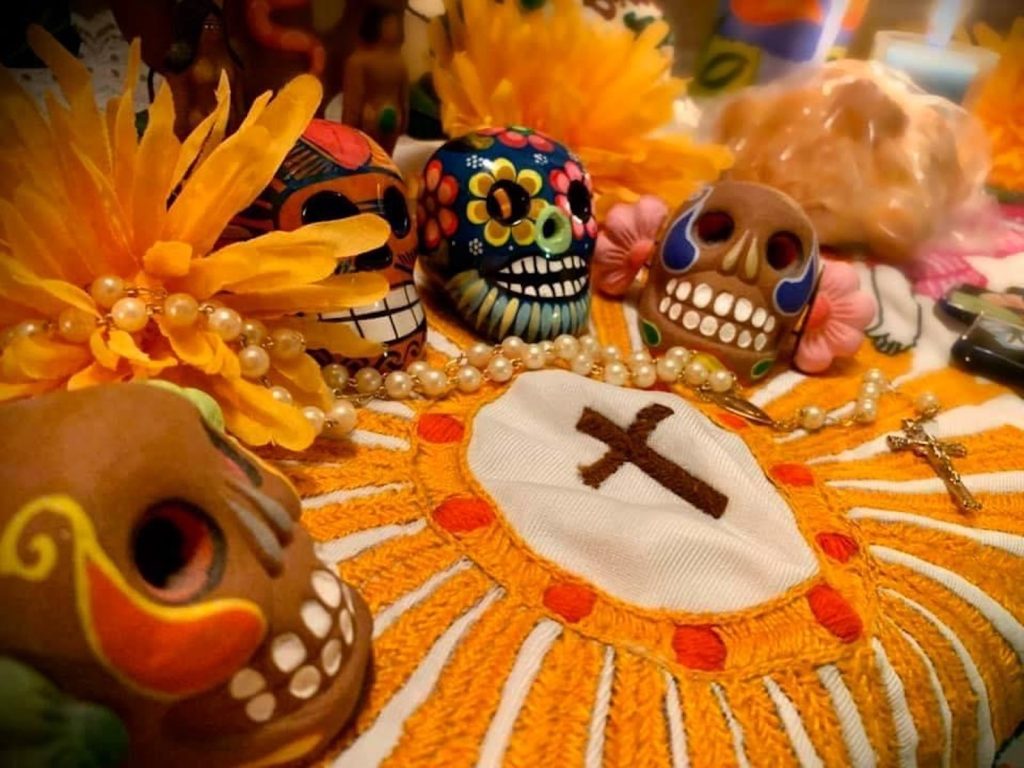
Conclusion:
Dressing up for Dia de los Muertos offers a wonderful opportunity to immerse yourself in Mexican culture. And celebrate the joy of life and remembrance. With the right elements and attention to detail. Your outfit can resonate with the authenticity and vibrancy of this cultural celebration. Incorporate traditional elements such as calavera makeup, skeleton-inspired attire, vibrant colors. And traditional fabrics to create a striking and meaningful look. Don’t forget to accessorize with floral accents, headpieces. And traditional Mexican footwear.


